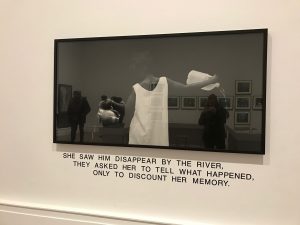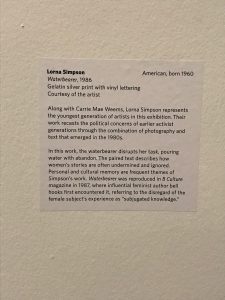A few weeks ago, I went to the Albright-Knox and saw an exhibition titled “We Wanted a Revolution: Black Radical Women, 1965-1985,” and one piece that stood out to me was Waterbearer (1986) by Lorna Simpson. The subject of the piece is a black woman who is pouring water out of two jugs—one plastic, one metal. I’ve inserted images of the piece below:


The caption of the piece reads “SHE SAW HIM DISAPPEAR BY THE RIVER./ THEY ASKED HER TO TELL WHAT HAPPENED./ ONLY TO DISCOUNT HER MEMORY.” This relates to the course themes we have encountered this semester: processes of memory and forgetting. The placard for this piece reads that the “paired text describes how women’s stories are often undermined and ignored” and that when “bell hooks first encountered it, [she] refer[ed] to the disregard of the female subject’s experience as ‘subjugated knowledge.’” I believe the placard is missing a crucial lens to explain this piece—that black women’s narratives are especially erased in processes of memory.
Black women and children’s recounts of narratives are often dismissed as paratext when the main body, or white, narrative is emphasized in the broader landscape. This artistic pushback against the mainstream rhetoric uses the art object to display a narrative often forgotten—and explicitly states the oppression of black women that is seen through the caption. The only—and main—figure in the piece melts into the dark background and the face is invisible—paralleling the masking of black women politically and socially. The water jugs—one metal, one plastic—are not even and the images alludes to Lady Justice. The scales, however, are not in balance, and the metal one is placed further down, like a scale tipping towards the object with higher capital. This object of higher capital symbolizes those who make more money, and are statistically white. This symbolizes how society values capital over humanity—and shows another axis of oppression. People of color are systematically economically oppressed, and therefore society renders them invisible.
This devaluation of people of color, especially those who come from economically depressed communities, can be seen in the treatment of people of color during Hurricane Katrina. After the hurricane, people of color who needed food to survive were marked as “looters” and were targets of violence from both police and white armed citizens. People of color who were on the lower rungs of the economic ladder were often criticized for not evacuating, even though many of them did not have the money to leave. Many faced violence through the state that refused to help them when they were displaced and in need, and continued to leave them stranded for months. The specific mention of the word “RIVER” in the caption also drew me in, since it reminded me of the mainstream narrative crafting black women who lost children during Katrina as “bad mothers,” and did not acknowledge their grief. When the societal paratext comes to light, those in power often respond with violence and erasure.
